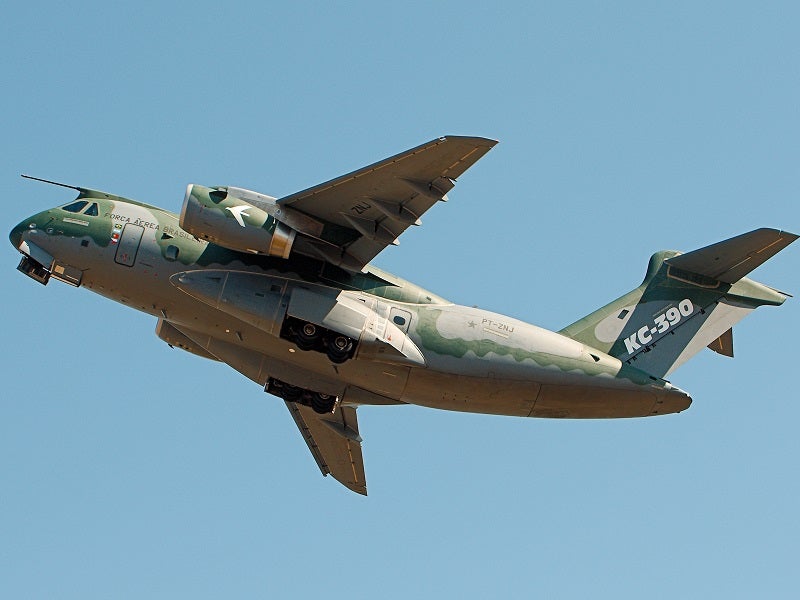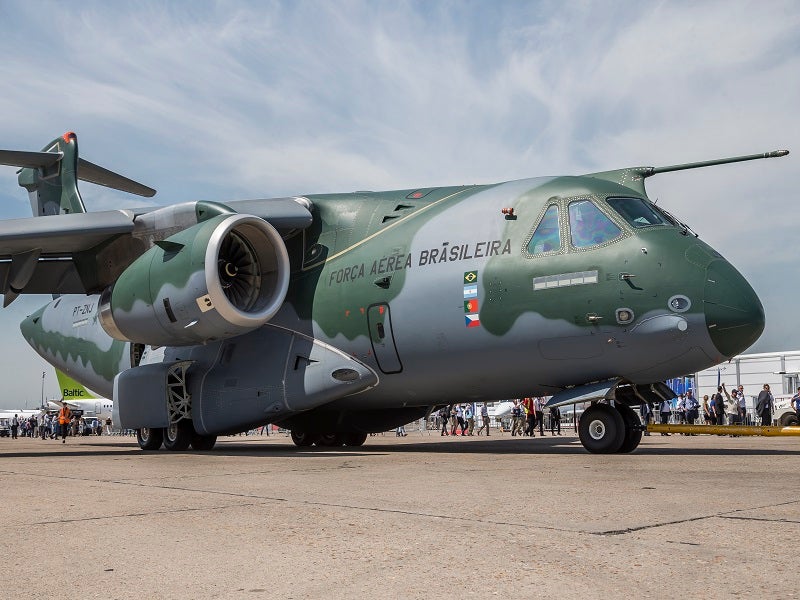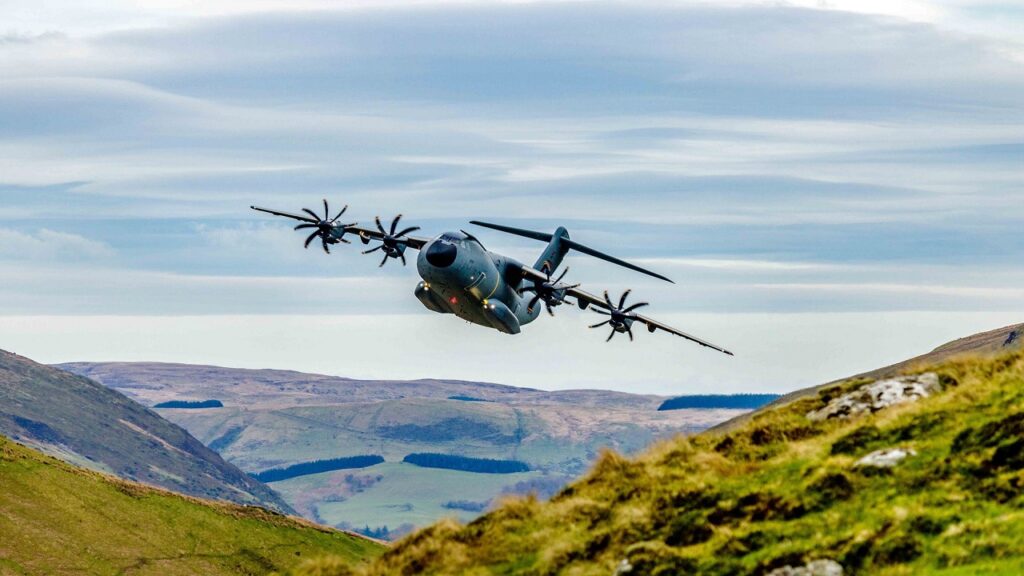The KC-390 is a medium-weight, multi-mission tactical aircraft designed and developed by Embraer, an aerospace company based in Brazil. It is the largest and most complicated aircraft ever built by Embraer.
The KC-390 can carry out a range of missions, including humanitarian support, medical evacuation (MEDEVAC), search and rescue, and aerial refuelling. Furthermore, it can be deployed to transport and launch cargo and troops and perform paratroopers operations.
Embraer, one of the world’s largest aircraft manufacturers, received a $1.3bn development order from the Brazilian Air Force (FAB) for KC-390 medium-weight military transport jet in April 2009. The new high-wing aircraft made its first flight in February 2015.
The KC-390 complies with the requirements of the new National Defence Strategy and meets the needs of the FAB. It will eventually replace the FAB’s Lockheed Martin C-130E/H and KC-130 aircraft.
The aircraft achieved initial operating capability (IOC) in December 2017 and received type certification from Brazilian aviation authority Agência Nacional de Aviação Civil (ANAC) in October 2018. Embraer announced C-390 Millennium as the aircraft’s new name for the global market in November 2019. The air-to-air refuelling (AAR) configuration retains the original designation.
KC-390 development
A study on the KC-390 (earlier named C-390) aircraft was presented at the LAAD 2007. The research and development of C-390 involved an investment of $600m, which was shared among Embraer and various partners led by the FAB.
The KC-390 prototype was assembled at Embraer’s Gavião Peixoto plant in Brazil.
Boeing and Embraer signed an agreement to co-operate on the KC-390 aircraft programme in 2012.
Embraer and the FAB concluded the critical design review (CDR) of the KC-390 aircraft in March 2013. The definitive aerodynamic and structural configurations, as well as the architecture and systems installations were confirmed for the immediate production of the first prototype aircraft.
Orders and deliveries
National Aeronautical Enterprise Empresa Nacional de Aeronautica (ENAER) of Chile signed a contract with Embraer to jointly build the KC-390 aircraft for the Chilean Air Force (CAF), in August 2010. Six aircraft were planned to be ordered for the CAF.
The Brazilian Air Force expressed its interest to acquire the KC-390 aircraft at the 47th Farnborough International Airshow held in the UK in July 2010 and signed the serial production contract for the aircraft in May 2014. First KC-390 aircraft was delivered to the FAB in September 2019. The handover ceremony was held at Anápolis Air Base, in the mid-western state of Goiás, Brazil.
The R$7.2bn ($3.3bn) contract required the company to supply 28 KC-395 aircraft over ten years. The contract also includes a logistical support package, including spare parts and maintenance. The order was revised from 28 to 22 KC-290 aircraft in February 2022 due to the FAB’s budget constraints. The deliveries are expected to be completed by 2034.
Embraer signed a letter of intent (LoI) with SkyTech for the purchase of up to six KC-390 multi-mission aircraft in February 2018.
The company received a contract from the Portuguese government to deliver five multi-mission KC-390 airlifters in August 2019. The contractual scope also includes services, support, and a flight simulator. Portugal is expected to receive the first aircraft in 2023.
The Portuguese Ministry of Defence (MoD) selected Elbit Systems to supply a complete electronic warfare (EW) suite for the new KC-390 aircraft in August 2019.
Embraer was contracted by the government of Hungary for the supply of two C-390 aircraft in the AAR configuration in November 2020. The production of the first C-390 Millennium for Hungary began in November 2021.
The Hungarian C-390 will be the world’s first aircraft with intensive care unit (ICU) in the AAR configuration. Embraer plans to deliver the first aircraft by 2024.
KC-390 design and features
The twin-turbofan-powered KC-390 aircraft is designed to be reconfigured in less than three hours to support different missions. It can be refuelled in flight and can be used for in-flight or on-ground refuelling of other aircraft.
The 20t jet is technically advanced and has fly-by-wire technology, which optimises mission results to reduce pilot workload. It also helps increase the safety and capability for operating on short and rustic runways.
The military aircraft has a cargo bay equipped with an aft ramp similar to Hercules aircraft and is capable of transporting a variety of cargo (weighing up to 26t), including armoured vehicles.
It is outfitted with state-of-the-art loading and unloading systems for handling cargo.
The KC-390 utilises computed air release point (CARP) technology integrated with fly-by-wire system to provide greater accuracy during air dropping, thereby reducing crew workload.
The twin-engine jet-powered Embraer KC-390 integrates the technological solutions developed for Embraer 190 commercial aircraft.
It can carry 84 military personnel and the cargo cabin can be configured for transporting the wounded or sick, on MEDEVAC missions.
The aircraft weighs approximately 23,600kg and its maximum take-off weight is 74,400kg.
Avionics
KC-390’ cockpit is equipped with Collins Aerospace’s Pro Line Fusion avionics system which features five 15in, night vision imaging system (NVIS) compatible, high-resolution LCD displays. The advanced human machine interface has an intuitive design with simplified access to functions such as flight planning, hazard avoidance, and aircraft performance monitoring.
The advanced avionics system enables enhanced situational awareness, due to its synthetic vision capabilities and graphical flight planning.
The Pro Line Fusion’s open architecture enables the integration of new technologies to meet changing operational requirements.
The system provides operational efficiencies through features such as automated database management, crew alerting system integrated with procedural checklists, and data link-enabled traffic and graphical weather information systems.
Self-protection features of KC-390 airlifter
The self-protection suite (SPS) of the tactical aircraft includes detection and countermeasures such as radar warning receiver (RWR), missile approach warning system (MAWS), laser warning system (LWS), enhanced vision system (EVS), and directional infrared counter measures (DIRCM).
The KC-390 features ballistic armour protection against 7.62mm bullets. It is also equipped with chaff and flare systems to distract and counter incoming missile threats.
Engines and performance
The aircraft’s propulsion system includes two International Aero Engines’ (IAE) V2500-E5 engines. The 2,400kg engine provides an upward thrust of approximately 31,330lb (138kN) and a fully electronic aircraft-to-engine interface.
The KC-390 can fly at a maximum altitude of 10,973m. Its maximum speed is 987.8km/h. The normal and ferry range of the aircraft are 2,590km and 6,130km respectively.
Landing gear
The rugged and reliable landing gear enables the aircraft to operate with heavy payloads and land even on semi-prepared airfields. The KC-390 is equipped with double chamber shocker absorber system and modern hydraulic systems.
Contractors involved in KC-390 programme
ELEB Equipamentos designed, manufactured, and supplied the landing gear system for the aircraft as part of a contract signed with EDS in March 2011.
FAdeA was awarded a partnership contract by Embraer Defence and Security (EDS) in April 2011 to build and supply spoilers, nose gear door, ramp door, flap fairings, tail cone and electronic cabinet.
IAE was chosen by Embraer in July 2011 to design, develop, supply, and install V2500-E5 powerplant in the KC-390 aircraft. It is a consortium comprising Pratt & Whitney, Pratt & Whitney Aero Engines International, MTU Aero Engines, and Japanese Aero Engines.
Rockwell Collins, now known as Collins Aerospace, signed an agreement with EDS to supply its Pro Line Fusion avionics system for the aircraft, in May 2011. The system renders improved situational awareness and decreases the workload of the pilot.
Embraer awarded a contract to BAE Systems to supply and install flight control electronics for the KC-390 transport aircraft, in July 2011.
Goodrich, which became part of Collins Aerospace, was contracted to design, build, and supply primary flight control systems in July 2011. The contractual scope included electro-hydrostatic actuators, electro-backup hydrostatic actuators, actuator electronics, and electrical controls.
Curtiss-Wright Controls was selected to supply rugged data acquisition systems for the KC-390 military transport aircraft in May 2013.
Rheinmetall is responsible for providing training devices for KC-390 aircraft, including cargo handling, procedure, and maintenance trainers as well as flight and mission training systems.
Aero Vodochody, a Czech aircraft manufacturer, was contracted to develop and produce the fixed leading edge of the wing (FLE). It is responsible for the industrialisation and production of all doors, cargo ramp and section II of the rear fuselage.
Cobham, now part of power management company Eaton, provided the 912E wing aerial refuelling pod for the KC-390. The refuelling pods were tested following the KC-390 flight testing in 2015.










